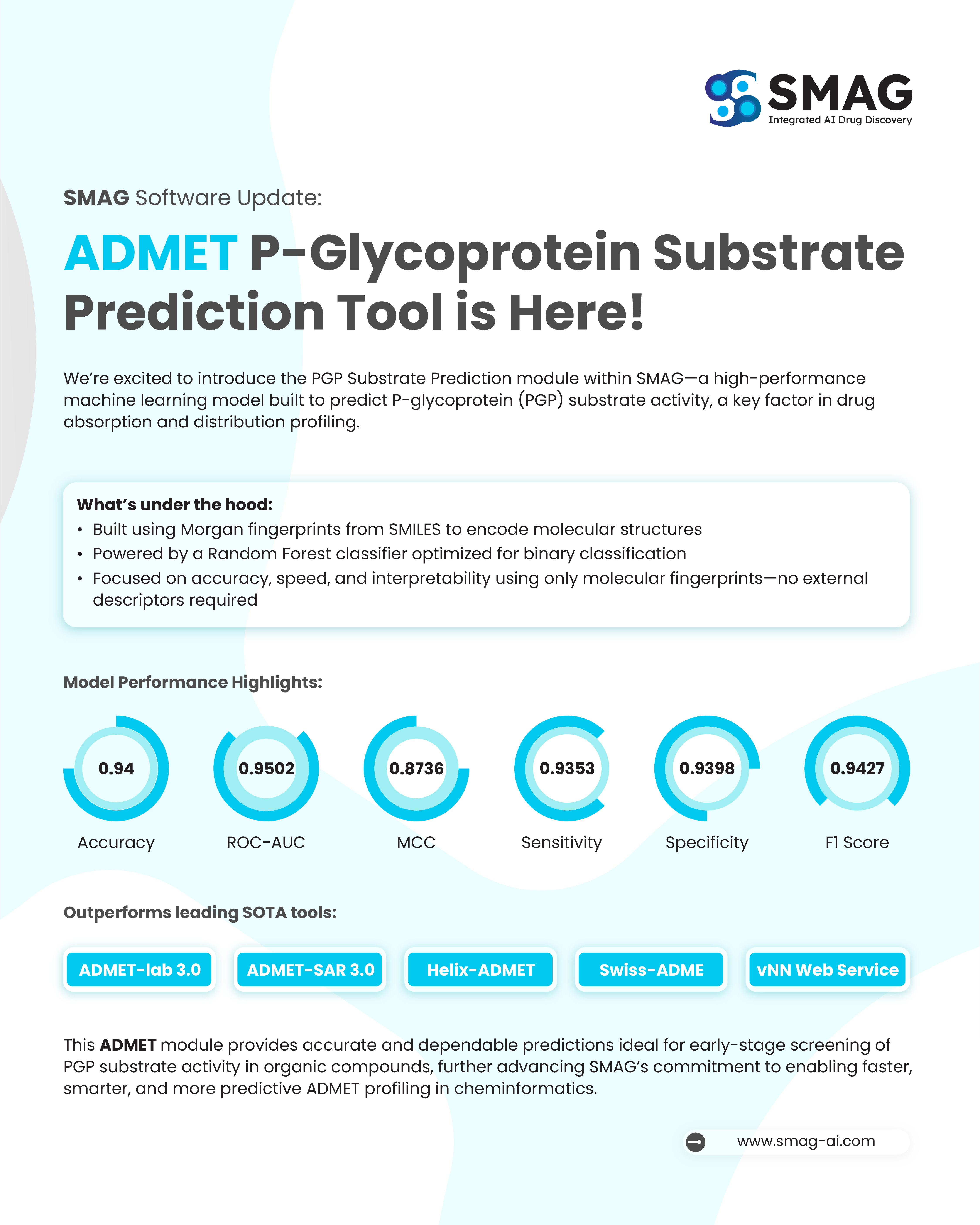
A New Milestone in AI-Powered ADMET Profiling
SMAG is proud to unveil the launch of its P‑Glycoprotein (PGP) Substrate Prediction Tool, now integrated into our platform’s ADMET module. This machine learning-driven model marks a new step toward accurate, fast, and interpretable drug toxicity prediction—a crucial component of modern AI in drug development.
Predicting PGP substrate activity plays a critical role in understanding drug absorption, distribution, and resistance, especially in early-stage compound screening. With this tool, SMAG empowers researchers to assess molecular behavior more reliably—reducing risk and speeding up the development cycle.
What Is P‑Glycoprotein and Why It Matters?
P‑Glycoprotein (PGP) is a membrane-bound transporter protein responsible for pumping drugs and xenobiotics out of cells. It can significantly affect:
- Drug bioavailability
- Blood-brain barrier permeability
- Multidrug resistance (MDR)
Identifying whether a compound is a PGP substrate is vital to ensure successful absorption, reduced toxicity, and optimized pharmacokinetics.
Powered by AI: What’s Under the Hood?
The SMAG PGP Substrate Prediction Tool is powered by a high-performance Random Forest classifier. It’s trained using Morgan fingerprints from SMILES strings—removing the need for any external descriptors.
Key Highlights:
- Binary classification optimized for precision
- Built entirely on molecular fingerprints for transparency
- Fast and scalable for high-throughput screening workflows
Model Performance at a Glance
| Metric | Value |
|---|---|
| Accuracy | 0.94 |
| ROC-AUC | 0.9502 |
| MCC | 0.8736 |
| Sensitivity | 0.9353 |
| Specificity | 0.9398 |
| F1 Score | 0.9427 |
These performance benchmarks place our tool ahead of industry-standard options in predictive toxicology.
Outperforms Leading Tools
SMAG’s latest ADMET feature surpasses the capabilities of several well-known software tools, including:
- ADMET‑lab 3.0
- ADMET‑SAR 3.0
- Helix‑ADMET
- Swiss‑ADME
- vNN Web Service
With superior predictive power and no need for proprietary descriptors, SMAG offers a uniquely scalable solution in cheminformatics and virtual screening.
Designed for Scientists, Powered by AI
Whether you’re in early-stage discovery, lead optimization, or toxicity filtering, the SMAG PGP Substrate Predictor enhances confidence in your screening pipeline. It helps reduce downstream failures and supports better decision-making with explainable outputs and efficient model interpretability.
Explore how SMAG uses AI in drug discovery to redefine early-phase development.

Related Tools
Frequently Asked Questions (FAQs)
Final Thoughts
SMAG’s new ADMET P‑Glycoprotein Substrate Prediction Tool represents a major leap in AI-driven drug development. Built on scientifically validated techniques and focused on speed, accuracy, and accessibility, it’s a must-have for anyone optimizing their drug pipeline.











